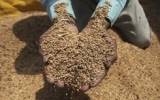US weighs timeline on pullout of 30,000 "surge" forces in Afghanistan
A looming US decision on troop drawdowns in Afghanistan could include a timeline for pulling out 30,000 "surge" forces deployed last year, Defence Secretary Robert Gates said.
In a farewell visit to Afghanistan before quitting as Pentagon chief, Gates indicated for the first time on Sunday that President Barack Obama may lay out a long-term plan for US troop levels over the next few years.  Defence Secretary Robert Gates (L) meets US soldiers in Paktika Province, Afghanistan. (AP Photo/Jason Reed,
Pool)
Defence Secretary Robert Gates (L) meets US soldiers in Paktika Province, Afghanistan. (AP Photo/Jason Reed,
Pool)
Obama is to reveal soon how many US troops will return home in July as control of security passes from foreign to Afghan troops in seven areas, amid reports that the figure could be higher than planned even a few weeks ago.
The transfer marks the first phase of a handover due to conclude by the end of 2014, when all foreign combat troops are supposed to have withdrawn.
Speaking to US Marines in southern Afghanistan's Helmand province, one of the war's worst battlefields, Gates said there were "two intermediate numbers that need to be resolved".
"One is, what is the size of the reduction that will be announced in July?" he said. "But the other is, at what point do you bring home the surge (forces)?"
Obama sent 30,000 extra troops to Afghanistan in a bid to reverse a Taliban insurgency that has become increasingly deadly since the 2001 US-led invasion brought down their regime, and vowed to begin a pullout by mid-2011.
The "surge" of US reinforcements implied a "temporary" move, said Gates, before asking: "So how long should the surge last?"
"And I think that is the second bookend, if you will, in the decision that I think the president is going to need to make over the course of the next few weeks," he added.
The US president convened his national security team on Monday to weigh in on the war in Afghanistan.
Senior administration officials and military commanders met in the White House Situation Room starting at 10:00 am (1400 GMT) for their monthly meeting on Afghanistan and neighbouring Pakistan, according to an official schedule.
With US public opposition to the war growing and patience in Congress wearing thin, Obama faces a difficult decision on troop numbers just as commanders say they are making headway.
The killing of Al-Qaeda leader Osama bin Laden by US Navy SEALs at his hideout in Pakistan last month has fuelled calls for a major withdrawal.
The New York Times reported on Monday that White House national security advisors are pondering much bigger reductions than those discussed even a few weeks ago following Osama's death and amid concerns over the war's cost.
Obama is expected to announce his decision on troop withdrawals in a speech to the nation this month, it added.
US officials were previously anticipating an initial drawdown of 3,000 to 5,000 troops, the paper said.
Gates said on the first day of his Afghan visit on Saturday that a "modest" number of troops would likely be pulled out in July.
He also argued for maintaining pressure on the insurgents to force them to the negotiating table - possibly by the end of the year.
In another visit to a base on the outskirts of Kandahar city, Gates made clear he would prefer to start pulling out support troops rather than combat forces, saying: "If it were up to me, I would leave the shooters for last."
However, he later acknowledged to reporters that withdrawal plans would have to draw from both support troops and combat units.
General David Petraeus, the US commander of foreign troops in Afghanistan, has also repeatedly warned against too hasty a withdrawal of troops, saying that while they have achieved considerable momentum, gains are fragile.
Gates, who is in Afghanistan until Tuesday, is touring the country saying farewell to some of the roughly 100,000 US troops stationed in Afghanistan as part of a 130,000-strong international force.
He is due to leave his job at the end of the month after four-and-a-half years and is due to visit US troops in eastern Afghanistan on Monday.
Parts of the east, which has a porous border with Pakistan where insurgents have hideouts, have seen fierce fighting in recent months.
Provinces like Kunar and Nuristan are now seen as being among the most dangerous in Afghanistan, alongside more traditional battlegrounds like Helmand and Kandahar in the south.
- AFP/de
 Indian PM announces 10-point plan to boost partnership with ASEAN
Indian PM announces 10-point plan to boost partnership with ASEAN
 Indonesia has potential to become Asia's new economic power: President
Indonesia has potential to become Asia's new economic power: President
 The spiral of conflict in the Gaza Strip
The spiral of conflict in the Gaza Strip
 Japan to help ASEAN keep closer watch on greenhouse gas emissions
Japan to help ASEAN keep closer watch on greenhouse gas emissions
 Thai transport ministry launches 2.68 trillion THB infrastructure project
Thai transport ministry launches 2.68 trillion THB infrastructure project
 New Japanese Prime Minister with the mission to restore trust
New Japanese Prime Minister with the mission to restore trust
 ASEAN+3 to grow at 4.2% in 2024: research office
ASEAN+3 to grow at 4.2% in 2024: research office
 Thai PM outlines vision for regional cooperation at ACD forum
Thai PM outlines vision for regional cooperation at ACD forum
 Vietnam - a prime example of effective cooperation with UNESCO: Official
Vietnam - a prime example of effective cooperation with UNESCO: Official
 Strong earthquakes strike Philippines, Tonga
Strong earthquakes strike Philippines, Tonga




